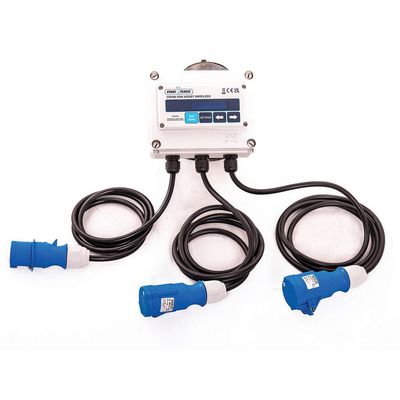

- Home
- Companies
- Evans and Pearce
- Products
- Evans & Pearce - Grain Fan Assist ...

Evans & Pearce - Grain Fan Assist Wireless (GFAW) Units
Simple, low cost system to turn existing grain cooling fans into automated units. Capable of switching fans on and off – only as required. Wireless control – only needs a power cable to each fan. A range to transform existing grain store fans into energy-efficient automated smart fans. As grain store specialists Evans and Pearce has developed a simple, low-cost system to turn existing grain cooling fans into automated units, capable of switching on and off only – as required for differential temperature crop cooling.
- Simple, uncomplicated system requiring minimal input from an electrical contractor
- Wireless control - only needs a power cable to each fan
- Each fan reacts to the condition of the crop around it, without any additional costs for store zoning
- Fan display gives real-time grain temperature reading - no need for additional sampling
- Can be retro-fitted to existing fans or specified on new units
- Automated control means fans only run as required, speeding up cooling times and cutting energy usage
Rather than wiring a GFA to an individual fan, our Grain Fan Assist Wireless Twin allows 2 x 1.1kw fans to be plugged in and controlled at the same time, monitoring crop temperature and ambient air temperature. Will run 2 x 1.1kw fans only when air temperature is low enough to effectively cool the crop. Avoids unnecessary fan running times. Will require 2 metre Crop Probe as detailed below. Inbuilt fan running time clock. Grain Fan Assist Wireless Twin arrives ready to use and requires limited installation.
Grain Fan Assist Wireless Twin (3ph)As above but with 2 x 16 amp 4 pin 3ph sockets. Includes starters and overloads for 1.1kw fans. Can be adapted to run 2.2kw fans if required.
Grain Fan Assist Wireless – 2m Crop ProbeMultiple units can operate from one Grain Fan Assist Wireless Crop Probe. Probe will monitor Crop Temperature, Ambient Temperature and Ambient rh. This probe can be used with GFAW, GFAW Twin and Multi Fan Hub.
- Grain Fan Assist Wireless can be supplied in three different versions:
- GFAW – Wired directly to an individual fan.
- GFAW Twin – 2 x 1.1kw fans can be plugged into a unit as detailed above.
- Multi Fan Hub – This automates the running of multiple 3ph fans, which are plugged into the hub. As standard available in 4, 6 or 8 fan versions.
Whichever version you choose, the clever controller monitors the difference in air and crop temperatures and triggers the fan to kick in every time the outside air is cold enough to effectively cool the grain. As external temperatures rise, the fan will then switch itself off, avoiding warmer air being drawn through the crop, undoing the good work done previously.
Operators can set the desired kick-in point simply via blister buttons and a digital display on the front of the box. This is known as Differential Temperature Grain Cooling – a technique that has been shown by the AHDB to reduce energy usage by up to 40%.
Grain Fan Assist Wireless can be fitted to new or existing fans and requires little, if any, input from an electrical contractor. Growers simply send their fans to us where we fit the control boxes, depending on spec. Any number of cooling fans can be equipped with this simple set-up.
Cooling Using Low Volume Ventilation
Temperatures above 15°C increase the risk of insect and mite populations developing. Relatively warm grain post-harvest is a good insulator, so heat is lost very slowly. Cooling permits grain to be stored at slightly higher moisture content and effectively increases the safe storage time.
Differential Controls
Differential controls have been shown to result in more efficient grain cooling, by switching the cooling fan on when the air temperature is lower than the grain temperature. Cooling systems have the potential to run whenever
‘air of a temperature to permit cooling’ is available and are automatically switched off once the grain reaches the ambient temperature. Reducing fan hours to reach the target temperature (in comparison with manual fan control) reduces energy costs.
“Temperatures fall more rapidly and to lower levels when using automatic compared to manual fan control”
If blowing with cooler air using a differential thermostat (4-6 °C difference), it is not possible to dampen grain.
For grain to become damp from blowing, you need a combination of:
- Excessive aeration rates
- Condensation around ducts
- Rain driven into uncovered external fans
- Successive days of condensing fog
